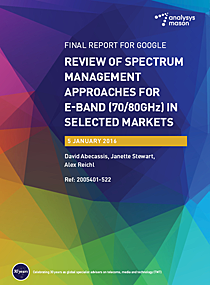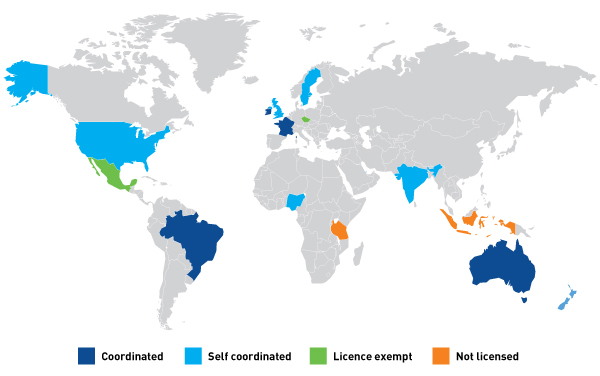Spectrum management approaches for E-BAND (70/80GHz) in selected markets
 This latest report explores how E-band frequencies have been licensed for use in selected markets around the world and identifies the regulatory regimes best suited to current and future uses of the band.
This latest report explores how E-band frequencies have been licensed for use in selected markets around the world and identifies the regulatory regimes best suited to current and future uses of the band.
E-band is part of the Extremely High Frequency (EHF) portion of the radio spectrum (broadly 30GHz to 300GHz), corresponding to wavelengths between 1mm and 1cm, hence the term 'millimetre waves'. Internationally, E-band includes the frequencies from 71–76GHz and from 81–86GHz.
Download the free executive summary or download the full report on the right.
About the report
The Analysys Mason report has been prepared in a context where there is growing demand for high-capacity point-to-point and point-to-multipoint wireless links:
- within telecoms networks (e.g. for backhaul) to provide high-capacity wireless connectivity to businesses and consumers
- in the context of new and innovative uses beyond conventional fixed point-to-point links.
The properties of E-band frequencies, particularly the available bandwidth and the channel sizes make this band ideally suited to meeting these demands:
- the large channel bandwidth (multiples of 250MHz) offers scope for considerably higher capacity to be delivered per link than with other fixed links bands
- the short wavelength of frequencies in the millimetre portion of the radio spectrum, where E-band sits, means that the potential for interference between neighbouring links is reduced, compared to the lower-frequency bands.
E-Band management approaches
As highlighted by the report, this combination of attractive channel characteristics and easy interference management offers significant opportunities for regulators to implement simplified coordination mechanisms for the licensing of links in E-band, compared to other frequency bands used for point-to-point services.
Adopting flexible, lightly licensed approaches when allocating these frequencies, as implemented in a number of leading countries such as the US, the UK and very recently Nigeria, to avoid the need for fully coordinated, interference-managed approaches to assignment, could unlock the significant potential of the E-band for innovative broadband communications.
Figure: Illustration of E-band management approaches adopted in surveyed countries [Source: Analysys Mason, 2015] 1

1 Analysys Mason also surveyed the status of the E-band in the Philippines, Peru and the DRC, but were unable to find complete information to develop case studies.
Downloads
Report Executive SummaryDOWNLOAD FULL REPORT
This report explores how E-band frequencies have been licensed for use in selected markets around the world and identifies the regulatory regimes best suited to current and future uses of the band.
Download your free copyAuthors

Janette Stewart
Partner, expert in spectrum management, policy and valuationLatest Publications
Podcast
Future trends and challenges in spectrum policy for mobile networks
Project experience
The case for replacing ALFs for UK mobile licensed spectrum
Report
Impact of additional mid-band spectrum on the carbon footprint of 5G mobile networks: the case of the upper 6GHz band
